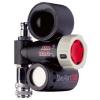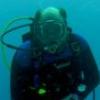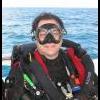EPIRB, Where can I compare and get one?
#16

Posted 18 June 2009 - 02:46 PM
The first, the one most of us are/should be concerned with is being near the boat but it is unable to see us. We want to assist the boat to see us. We do NOT want to alert the whole world that we have a major problem, because typically we don't.
The second, which many of these answers are inexplicably majoring on, is getting rescued when we're by ourselves in the middle of a wide ocean. Highly relevant to cross -ocean sailors, not I suggest to scuba divers except in rare instances.
#17

Posted 19 June 2009 - 12:39 AM
"Chief Special Warfare Operator (SEAL) Eric Shellenberger experienced serious problems during a training dive in Bremerton in Washington State and did not survive."
http://blog.usnavyse...h-drowning.html
By USNavySeals
Posted June 21st, 2009
=====
He clearly loved the life in the sea. http://www.coldwaterimages.com/
Ohana.
Legacy of the Deep
"Kawika Chetron lived for his time spent at sea, and his time there spawned a treasure of ocean images."
http://www.sfgate.co...MNGMROVNMM1.DTL
Carl Nolte, San Francisco Chronicle Staff Writer
Sunday, April 1, 2007
=====
U.S. Coast Guard divers died in Artic
"What I can tell you is this: These people were very well trained. Every time we did something we had to have a safety briefing,"
http://www.cdnn.info...ty/s060923.html
By Gene Johnson
SEATTLE, Washington, September 23, 2006
Edited by Wakemaker, 28 June 2009 - 12:34 PM.
#18
 Guest_Sea Urchin_*
Guest_Sea Urchin_*
Posted 19 June 2009 - 06:54 AM
Rest in peace, David.
#19

Posted 19 June 2009 - 09:54 AM
#20

Posted 20 June 2009 - 05:24 PM
What would you suggest?
- The Perfect Storm
Plot: Based on a true story, an unusually intense storm pattern catches some commercial fishermen unaware and puts them in mortal danger while they are at sea.
Movie trailer
<A href="http://www.imdb.com/...y/vi737673497/" target=_blank>[url="http://"http//"http://"http://"http://www.imdb.com/video/screenplay/vi737673497/"""""]http://www.imdb.com/video/screenplay/vi737673497/[/url]
The other feelings that happen during distress.
- Open Water (2003)
Plot: Based on the true story of two scuba divers accidentally stranded in shark infested waters after their tour boat has left.
Movie trailer
http://www.imdb.com/...40793/</strong>
A diver with a marine radio may have been able to call the dive boat back to get them, on Channel 16, since the boat was likely still in radio range when the couple surfaced.
- Open Water 2 - Adrift (2006)
Plot: Based on a harrowing true story about a weekend cruise aboard a luxury yacht that goes horribly awry for a group of old high school friends who neglected to lower a boarding ladder before they jump into the ocean for a swim.
Movie trailer
http://www.imdb.com/video/screenplay/vi2180907801/
The yacht could have had a Category I EPIRB aboard.://http://www.imdb.com/video/screenpla...[/i]IRB aboard.
- The Guardian (2006)
Plot: A high school swim champion with a troubled past enrolls in the U.S. Coast Guard's "A" School, where legendary rescue swimmer Ben Randall teaches him some hard lessons about loss, love, and self-sacrifice.
Movie trailer:
<A href="http://www.imdb.com/.../vi1911750937/" target=_blank>[url="http://"http//"http://"http://"http://www.imdb.com/video/screenplay/vi1911750937/"""""]http://www.imdb.com/video/screenplay/vi1911750937/[/url]
Various SAR missions executed to rescue people in the water.
- It Came From Beneath the Sea (New color special edition DVD) (1955)
Plot: A Giant Octopus, whose feeding habits have been affected by radiation from H-Bomb tests, rises from the Mindanao Deep to terrorize the California Coast.
Movie trailer:
http://www.imdb.com/...05849/</strong>
Aww. It's just a marine horror classic.
- The Abyss (1989)
Plot: A civilian diving team are enlisted to search for a lost nuclear submarine and face danger while encountering an alien aquatic species.Movie trailer
http://www.imdb.com/video/screenplay/vi264...057/
Most of the trouble is underwater where communications and decompression make rescue difficult.
- Dante's Peak
Without warning, day becomes night; air turns to fire, and solid ground melts beneath white-hot lava. Welcome to the town of Dante's Peak, where a long-dormant volcano is about to erupt with devastating force. Who will survive when the inferno unleashes its fury?
Movie trailer
http://www.imdb.com/video/screenplay/vi2745172249/
There a part where a latent satellite rescue transponder signal finally gets recognized by the HQ.
- Jaws (1975)
When a gigantic great white shark begins to menace the small island community of Amity, a police chief, a marine scientist and grizzled fisherman set out to stop it.
Movie trailer
http://www.imdb.com/video/screenplay/vi413...49/
Edited by Wakemaker, 28 June 2009 - 07:29 PM.
#21

Posted 20 June 2009 - 10:13 PM
Here's one diver related SARSAT rescue, but not diver activated:
On 09 April 2005, the COSPAS-SARSAT system detected a 406 distress signal in position 27 27 N, 082 55 W. The operator of the F/V Sea Drive manually activated their 406 MHz EPIRB when they lost the location of one of their divers in the water. CGD7 RCC launched a HH-60 helicopter and a Coast Guard utility boat to the area. The utility boat arrived on scene and spotted a strobe light 9 NM SW of Tampa Bay, FL. The diver was found safe without any injuries and returned to his vessel. The Coast Guard helicopter was stood down before arriving on scene. One SARSAT Rescue.
Coordinated international effort leads to rescue of two men off Costa Rica
Monday, April 27, 2009 3:05 a.m.
Ed Skinner, a search and rescue coordinator at the U.S. Coast Guard Rescue Coordination Center in Alameda, Calif., responds to an Electronic Position Indicating Radio Beacon alert that triggers the response, search and eventual rescue of Szukics and Winningham 50 miles west of Costa Rica. The EPIRB is registered to the Black Pearl, a 55-foot pleasure craft homeported in Loch Lomond Marina, San Francisco.
This and countless other EPIRB alerts are triggered via a series of satellites operated by the National Oceanic and Atmospheric Administration. NOAA weather satellites pick up the 406 MHz EPIRB signal and send an electronic message to the United States Mission Control Center which then electronically accesses the registered information entered online by the owner of the EPIRB. The current position and registration information is relayed electronically from the USMCC to the nearest rescue coordination center.
After receiving the alert from the USMCC, Skinner starts to gather information in order to narrow down a possible search area. From a complete registration of the EPIRB, the Coast Guard has a description of the vessel, name of the vessel, and personal contact names and numbers. And, after talking with Szukics sister, the Coast Guard also now has a copy of the Black Pearl’s float plan and last known port call, a small town in Mexico.
3:56 a.m.
The Coast Guard receives two possible positions from the NOAA weather satellites, 138 nautical miles south southwest of the Mexico and Guatemala border, or 50 nautical miles west of Cabo Velas, Costa Rica.
4:01 a.m.
The RCC in Alameda runs an Automated Mutual-Assistance Vessel Rescue alert notifying merchant vessels in the vicinity of the EPIRB signal of a possible distress at sea. AMVER is sponsored by the United States Coast Guard and is a voluntary global ship reporting system used worldwide by search and rescue authorities to arrange for assistance to persons in distress at sea.
4:37 a.m.
Because of the location of the Black Pearl’s EPIRB signal, watchstanders at the Rescue Coordination Center in Alameda contact the rescue coordination center in Costa Rica, in compliance with the Safety of Life at Sea Treaty of 1974.
The SOLAS Convention is generally regarded as one of the most important of all international treaties concerning the safety of merchant ships. The first version was adopted in 1914 in response to the Titanic disaster. This treaty outlines each participating country’s search and rescue area of responsibility.
8:23 a.m.
RCC Alameda passes the updated EPIRB position to a law enforcement aircraft in the vicinity and asks them to fly over the position. The air crew does not see any signs of distress. The aircraft is able to hear the 121.5 MHz homing signal but can not track it because the aircraft does not have direction-finding equipment.
11:44 a.m.
RCC Alameda contacts an amateur radio operator and requests assistance with HAM NET radio communications. The operator passes information about possible people in distress to fellow HAM radio operators in the South American region.
2:13 p.m.
Another search is conducted by a law enforcement aircraft with negative results. The air crew confirms they hear a 121.5 MHz beacon and tries to hail the vessel on channel 16 VHF, but receives no response.
3:15 p.m.
An AMVER vessel headed to San Diego diverts to the search area with an estimated time of arrival of 7:30 p.m.
4:30 p.m.
The law enforcement aircraft completes another search with negative results.
7:25 p.m.
The AMVER vessel reports they have a small craft on their radar, approximately four nautical miles off their port bow. The small craft is not responding to radio calls. The same AMVER vessel arrives on scene shortly afterward and sees no signs of distress nor anything on the radar. The vessel is released and continues toward San Diego.
8:30 p.m.
In coordination with Costa Rican authorities, the RCC Alameda formulates a plan to divert the Coast Guard Cutter Sherman, a 378-foot high endurance cutter homeported in Alameda, Calif. on a law enforcement patrol in the Eastern Pacific, and conduct a first light search with a C-130 aircraft beginning the next morning. The Sherman has an ETA at the search area of 7 a.m. Tuesday.
Tuesday, April 28, 2009 2:11 a.m.
RCC Alameda receives the 22nd position update of the EPIRB signal from NOAA weather satellites. The EPIRB signal has moved nearly 17 miles since the original position was passed 22 hours ago. The new position of the EPIRB signal is passed to the Sherman.
6:30 a.m.
A Coast Guard C-130 crew from Air Station Sacramento is airborne and en route to the predetermined search area. Factors used for selecting a search area include accuracy of data, the number and capabilities of search and rescue assets, environmental conditions, size of search target and type of detection aids.
7:20 a.m.
The Coast Guard C-130 aircrew spots a life raft in the vicinity of the EPIRB position and contacts the Sherman, which is approximately 50 miles away and en route. The ETA of the Sherman is 2.5 hours. The C-130 aircrew confirms that there are two survivors in the life raft.
The Coast Guard assets that eventually locate Szukics and Winningham in their life raft have direction-finding equipment that was able to home in on an exact position being transmitted via satellite.
7:50 a.m.
The C-130 aircrew drops supplies to the life raft that include food, water and a radio. The Sherman makes communication with the two men in the life raft and confirm they are Szukics and Winningham from the Black Pearl.
8:40 a.m.
RCC Alameda contacts Costa Rican authorities and reports locating the mariners that had been missing.
9:34 a.m.
The Sherman arrives on scene, launches its smallboat and prepares to rescue the two survivors.
9:48 a.m.
The crew of the Sherman successfully transfers the two survivors from the life raft to the cutter.
“The captain of the Black Pearl helped save his own life and the life of his shipmate by taking his EPIRB with him when they abandoned ship…great move,” said Capt. Jay Jewess, Chief of Incident Management Branch Eleventh Coast Guard District. “Without doing this, I’m not sure we would have found them as the C-130 was able to home right in on them using their DF-430.”
“They told me they were pretty darn happy to see that Coast Guard aircraft wave its wings at them this morning...”
http://coastguardnews.com/coordinated-international-effort-leads-to-rescue-of-two-men-off-costa-rica/2009/05/01/
"Satellite distress beacons [EPIRBs and PLBs] have saved over 22,000 people world wide since the international Cospas-Sarsat (Search and Rescue Satellite Aided Tracking) System became operational in the 1980's."
Great! So, um, how many are SCUBA related, and what were the circumstances, I wonder? I also wonder if this includes military (combat) rescues.
Other True Stories
===== ===== =====
Open Water (2003)
"The true story behind the disturbing movie... The danger in the blazing heat of tropical Queensland is that, without fresh water, someone floating in the middle of the ocean may dehydrate long before help can arrive."
http://www.cdnn.info...le/a040723.html
===== ===== =====
Missing Divers - May 2008, Great Barrier Reef
"Police said the experienced divers surfaced yesterday afternoon around 650 feet from the dive boat but were unable to raise the crew."
http://www.singlediv...showtopic=15849
Edited by Wakemaker, 08 July 2009 - 01:26 AM.
#22

Posted 20 June 2009 - 10:42 PM
http://www.boatus.com/mmsi/
"Hey, what is DSC?"
Consider a "handie-talkie" (Motorola terminology) that is water proof. They're small enough to take on a dive. Um, it might be a bit conspicuous tucked into a bikini.
Edited by Wakemaker, 21 June 2009 - 03:40 PM.
#23

Posted 21 June 2009 - 10:47 PM
[I'm confused about the EPIRB, PLB and ELT descriptions for frequency uses. 406 MHz is the satellite frequency. It cuts through the upper atmosphere. 243 MHz is former US military version of the civilian 121.5 MHz frequency, used for homing. I've been noticing many referenes to 121.5 MHz being a satellite frequency. 121.5 can refract in the atmosphere, and ducting can occur. If it really was used by satellites, then that may be a reason it is no longer.
121.5 is the aviation distress frequency. It's the frequency that aircraft Emergency Locator Transmitters transmit on and the voice channel that pilots who aren't already talking to Air Traffic Control will go to in an emergency if they have time to communicate. It's used by other services since it's supposed to be monitored by aircraft when possible as well as being monitored by ATC (although they're less like to hear anything since they're ground based). The biggest problem the SAR folks were having with satellite monitoring of 121.5 was false alarms. Only 1 in 5 alerts came from actual emergency beacons, the rest from inadvertent transmitters including ATM machines and pizza ovens. Overall 2 in 1000 alerts ended up being real distress. Combine the false rate that with the fact that they don't have any information other than there's a signal and it's location within about 15nm, and you can see why they typically didn't dispatch without picking the signal up on several satellite passes or a known Mayday in the area. A lot of times they'd dispatch the Civil Air Patrol to find a beacon, and CAP would track it to an airport where an airplane's ELT was going off because someone bumped the switch or the pilot landed too hard, and then they'd contact the owner to get them to shut it off from the registration number on the aircraft.
The answer was to take the system digital. With digital you can be certain that what you're receiving is actually a beacon, and it can in include identity information as well as location information. With a digital beacon, they'll know that it's the ELT from N123SD, be able to look up the owner, and call them to see if they're ok without ever having to get anyone out to track the signal. At the same time they wanted to go digital, they wanted to add a lot more users to the system via the Personal Locator Beacon, where you had John Q. Public buying gear without any training. Given all of this, it made sense to move it off the aviation distress frequency (which is AM and voice-based) and crank up the power (406 beacons transmit about 5W of power, 121.5 send about 0.1W of power).
With 406, the false positive rate has dropped to 1 in 12 alerts being false, and 70% of the false alerts are resolved via phone/radio before sending anyone into the field.
We're talking about two different scenarios with completely different solutions.
The first, the one most of us are/should be concerned with is being near the boat but it is unable to see us. We want to assist the boat to see us. We do NOT want to alert the whole world that we have a major problem, because typically we don't.
The second, which many of these answers are inexplicably majoring on, is getting rescued when we're by ourselves in the middle of a wide ocean. Highly relevant to cross -ocean sailors, not I suggest to scuba divers except in rare instances.
Oh, I don't disagree. As I said earlier, I own a PLB but haven't seen the need to take it with me diving in the conditions I typically see, whereas I do take a 6 foot SMB + signal mirror + storm whistle with me on every dive.
It's not inexplicable that the answers are centering on EPIRBs/PLBs/ELTs, when that's what the original poster was asking about. I was confused why you were talking about boat based solutions.
#24

Posted 22 June 2009 - 10:19 AM
...Only 1 in 5 alerts came from actual emergency beacons, the rest from inadvertent transmitters including ATM machines and pizza ovens.
If an ATM puts out a distress call AFTER someone's checking account is in the red, then it's probabaly too late. Same goes for the pizza burning in the oven!
Many seasoned SCUBA divers have had to intervene when one of their dive buddies developed a problem on a dive. At times, simple hand signals and eye contact was enough to provide for a meaningful slow ascent together. Stopping long enough for your buddy, groping for your octopus, was all that was needed on other occasions.
EPIRBs and PLBs are for search and rescue. Any sky diver who carries one, might be considered wise, by some. I'm trying to convey the urgency caused by the pain of being in distress.
A diver's transition from "Excuse me. I need to use your Spare Air," to "Oh, God! Somebody save me! Quick!" can be too sudden for notification or have been overlooked for hours, locking the diver onto a path of very few options and obvious outcomes.
We use a rule of thumb; "One minute of life per degree of water temperature." I think hypothermic conditions cause drowning. The cause of death may have been drowning, but that drowning was due to hypothermia, exhaustion/dehydration, injury, unconsciousness, or whatever. SCUBA divers have drowned because of strong current, disorientation, entanglements. These especially bother me because one might laugh at their initial "need for assistance." The divers look at their gauges realizing they've got 30 minutes of air to get out of their situation. From then on, they're going to have to hold their breath.
I've had the opportunity to chat with a man who lost his boat while sailing on the pacific. He was so weak on the third day of being in the ocean he was pathetic.
If one activates a SAR mission, they're hoping to out last the pain and distress they are experiencing; being found or self-rescue in not likely to occur in time.
I've noted that some dive buddies, die together because they are in the danger zone together. That "danger zone" might be an attitude (complacency, intellectual incompetence), dive profile, level of risk (I include physical incompetence for a task), proximity to the source.
EPIRB and PLB units that SCUBA divers are considering are not warranted for repeated exposure to submersion and pressure so they might not perform as expected AFTER A DIVE. We should consider that into the risk evaluation. Electronics MIGHT be of benefit to a diver in distress provided certain conditions/circumstances. What if your distress is realized at a depth of 20 feet, or what if it's 90 feet and you push the activation button? What if the tidal effects have put you into a rocky canopy upon surfacing? What if divers go ashore only to find themselves lost with bad weather and storm winds whipping-up? After surfacing Dive Bud passes out and you turn on the EPIRB, drag 'em to dry land all by yourself while they breath shallow breaths, is the only first aid what's left in your Nitrox tanks?
What should the diving community really expect an EPIRB to do for them? Here's another one that's said to be rated to 30' Litton Micro B EPIRB XX. The unit may float. That makes sense because the distressed diver may not be able to continuously support a negatively buoyant unit above water for the entire rescue evolution.
Is the diver unconscious? If "yes," then EPIRB response might be too slow and take too long. Instead, tell someone with access to a phone or radio transceiver, "You! Call nine-one-one and tell them a SCUBA diver is unconscious, indicating where we are so they can get here right away! Inform them I just activated an EPIRB."
Diver distress can't wait. Otherwise, it's probably not distress. What scenarios are we up against? Apply diver distress avoidance by getting assistance before distress happens.
"We're showing 35 feet and my BC's about to explode. Here. Do you mind...?"
I was having a conversation with a divemaster I know, about the topic, and learned about another case in which an EPIRB or PLB could have saved a diver; while boat diving an oil rig, the diver was separated from both dive buddies. Upon surfacing, fog obscured the area. The the dive boat was holding station where the divers entered the water and this particular diver wound up on the opposite side of the oil rig. At this point, this is about a diver in need of assistance. The mistakes made by the dive boat exaberated this situation and they departed for the second dive location which was miles away from the oil rig. The diver who was mistaken to be aboard, drifted away from the oil rig. The rig was miles off the California Coast. At this point, I'd say we have a diver in distress. Being found is not likely in fog. Self-rescue options are not apparent because it's not likely the diver will make it to shore in the apparent current. This diver could have used the EPIRB as soon as it was too difficult to get back to the platform. Actually, the diver didn't know the boat thought he was in the water after reaching the second dive location. A SAR mission was launched and the Coast Guard helicopter search the second site because the dive boat logged the diver's entry at that site.
Initially, when this diver was at the surface on the opposite side of the rig, merely in need assistance, a Dive Alert Safety Horn (surface/subsurface signaling device), or safety whistle (one that works even when wet), would have brought the boat over for boarding. The three separate court hearings that followed would never have occured with the use of a simple whistle. Case against the divemaster. Case against the captain (I think this was criminal). Case against the company. And other negative effects include a few people who learned of this ordeal and stopped diving. Had an EPIRB or PLB been used, various trials may still have taken place with an additional case against the manufacturer (manufacturer did not inform diver with a disclaimer against using the EPIRB unit while diving or something) or the expert withness. Perhaps both.
In this incident, using an EPIRB or PLB, would have been enough to provide SAR coordinators more time to effect a rescue due to the fog AND issue bulletins alerting vessels in the area to keep a sharp lookout -- with an "Personal EPIRB" the diver would have been found by boats, even in fog. What actually happened was the fog cleared and an old fashioned sailing vessel, with a sharp lookout in the crows nest, found the water logged man in time.
Edited by Wakemaker, 28 June 2009 - 01:08 PM.
#25

Posted 28 June 2009 - 01:45 PM
...going out by yourself...
My opinion is, "Never swim alone." I'm also disinclined to bathe in hot oil and Bisquick.
I'm not surprised that a close friend of mine will go hiking/camping alone in the wilderness (Arizona). He also does abalone diving alone.
I'm not surprised that some of my friends go hunt predators alone (big cats that are killing their cattle).
I'm not surprised one guy I know found everyone sleep on a camping trip last week at sunrise so he went kayaking to a cave he likes and entered it alone on foot.
I'm not surprised that some of my colleagues go boating alone (to enjoy fishing outside the Golden Gate Bridge).
I'm not surprised that some of my PADI professional diver friends go diving alone (intentionally, knowingly, while recreationally).
I'm not surprised that Americans drive cars and trucks alone (even at night, in all kinds of weather with vehicles that are in unusual operating condition).
I'm not surprised that I'm inclined to fly alone (solo time is required for private pilot certification).
One of the aforementioned groups is inherently dangerous.
One of the groups, on the other hand, is likely to have distress and survival situations arise.
Yet, one of these groups, while compensating for so many challenges, has relatively few deaths.
And, one of these groups, while taken for granted, is cited to kill an American, every 13 minutes.
Some do live to tell about "it."
http://www.spareair..../reportdata.htm
I prefer to dive for fun. If I ever do dive for work, you know I'm going to be enjoying it!
Edited by Wakemaker, 04 July 2009 - 02:13 AM.
#26

Posted 28 June 2009 - 01:56 PM
#27

Posted 28 June 2009 - 05:43 PM
How was your abandoned diver eventually found, and how long was he adrift?
Someone on a commercial vessel spotted him in the water AFTER the fog cleared. The helicopter was looking in the wrong place due to misinformation. I'm told the diver was adrift for about 5 hours. He had given up all hope of rescue by that time.
If a SCUBA diver is adrift and in need of rescue, why keep the SCUBA tank? I would have responded by ditching the weight belt and shifting my BCD to provide best "face-up" orientation at the surface. I might even scuttle the air tank (after opening the valve all the way), and possibly drop it along with the hoses and regulators, depending on the weather forecast. The lower our face is to the water, the more difficult it is to breath during heavy winds and surf. If I found myself on a dive in need of rescue, I'm going to evolve into diver survival mode rather rapidly.
I don't understand why divers in distress keep all the negatively buoyant gear. Never surrender. Never give up.
#28

Posted 28 June 2009 - 07:02 PM
I tried to find the original thread about the lost divers who ended up sharing an island with dragons. About a year ago. Can't find the original thread, but here are several so people can work out what happened:-
http://www.scubaboar...ore-rescue.html
http://www.scubaboar...ional-park.html
http://www.scubaboar...ional-park.html
http://afp.google.co...tE3il4vwuKRdGnA
#29

Posted 05 July 2009 - 03:37 AM
http://www.acrelectr...px?sku=2797.4NH
This EPRIB is small enough to be placed in a waterproof and PRESSURE proof container and carry below to REC diving depths...
McMurdo Fastfind Plus PLB with Built-in GPS
Is this a Category II or a Class B? We all seem to be using the term "EPIRB" regardless of the class, category or geographic location. McMurdo is apparently a company in the UK. Their parent firm is Signature Industries Ltd, of London. If you live in the USA you can get a Category II for your PLB. It might be illegal to sell Class B in the USA. However, other countries may permit you to buy and use a Class B unit. But, should you? Where are you planning to use the unit? Will that matter much? There are indications that some divers are using a Class B on their boats (possibly in substitution of a Category I). This might be because the difference is not understood.
McMurdo Fastfind Dive Canister
"Features: Waterproof to 492 feet. Built to hold Fastfind and Fastfind Plus. Adds one pound positive bouyancy."
If you were going to buy a unit today, is this the one you would pick? This company has a canister to protect the PLB while in a diving environment. I'm unable to find any reference on the McMurdo site indicating the Fastfind series is made for diving at this time. There are many bloggers stating Fastfind is for divers. The canister may meet your water-tight requirement for depth
Edited by Wakemaker, 06 July 2009 - 02:25 AM.
#30

Posted 05 July 2009 - 11:26 AM
"For the diligent diver, closed circuit rebreathers are actually safer than open circuit scuba." Tom Mount
0 user(s) are reading this topic
0 members, 0 guests, 0 anonymous users


















